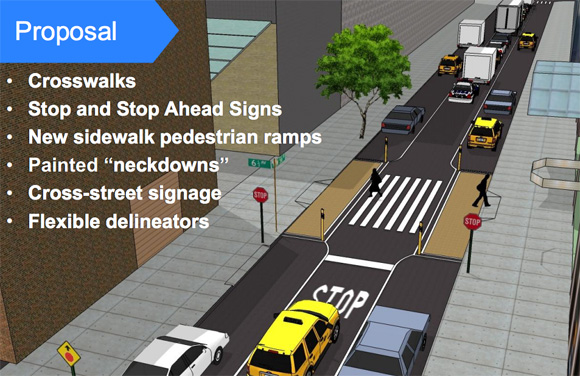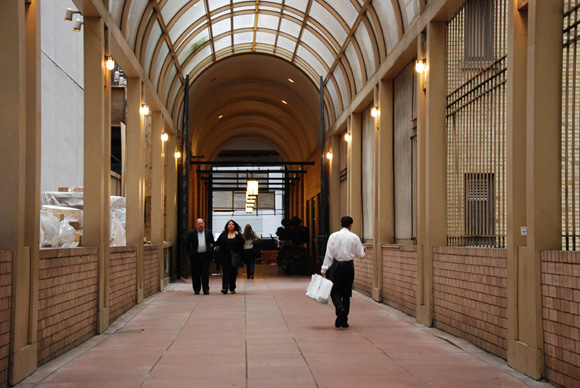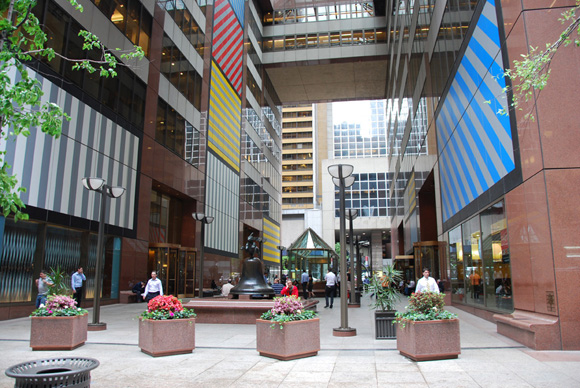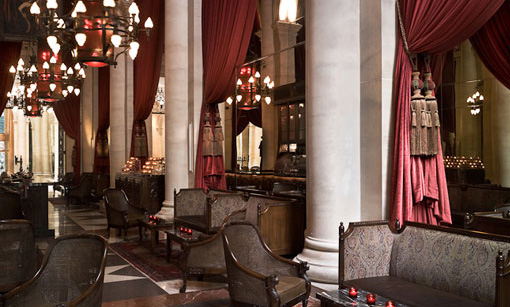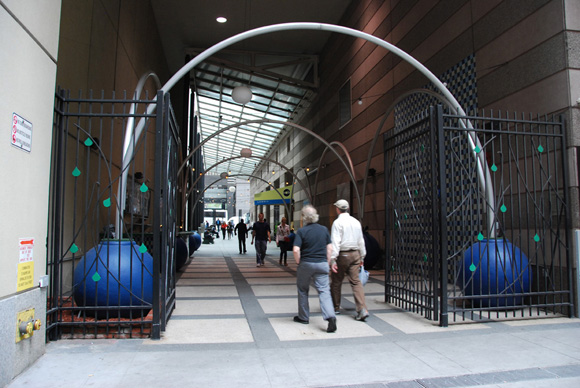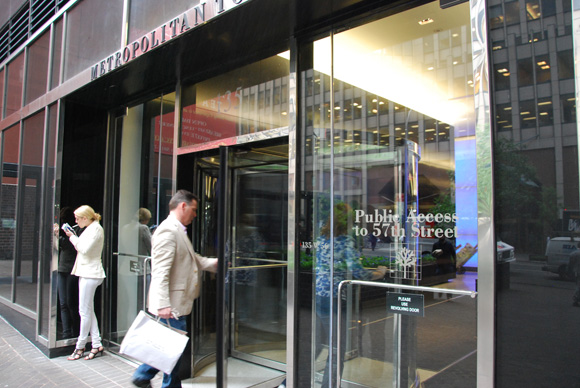
"It's a private property with public access," a security guard explained after stopping me from taking photos of a mid-block passageway through the Metropolitan Tower on 56th Street. The space in question, which connects 56th to 57th Street between Sixth and Seventh Avenues, is one of more than 150 privately owned public spaces in central Midtown, many of which are products of a 1980s zoning program to improve pedestrian circulation. In exchange for development bonuses that today are worth millions of dollars in rentable square footage, developers were supposed to build and maintain publicly accessible mid-block passageways to help ease pedestrian congestion on the heavily used north-south avenues. The problem is many of these semi-public spaces now appear so private, most walkers wouldn’t even know to use them.
This summer, the Department of Transportation is looking to change that with a series of midblock crosswalks tying 51st Street to 57th Street between Sixth and Seventh [PDF]. Approved earlier this month by Community Board 5, the crosswalks will string together six passageways and enhance a much-needed pedestrian path on some of the most-walked streets in the city. The project is an important first step toward reclaiming several privately-owned public spaces — or POPS, as they're known — that could be doing much more for Midtown pedestrians.
POPS are the product of New York's epochal 1961 zoning law and come in all shapes and sizes, from passageways and arcades to plazas and parks. The basic idea is that developers can erect taller buildings if they provide and maintain a public amenity. These amenities can be as utilitarian as a covered outdoor passageway — for example, the Rihga Royal Hotel’s POPS connecting West 54th and 55th Streets between Sixth and Seventh Avenues — to the more intricate, landscaped Zuccotti Park in lower Manhattan.
As the Occupy Wall Street protests at Zuccotti demonstrated, these semi-private, semi-public spaces inhabit a legal grey area. Different rules apply to each space, from the hours the space is accessible to the number of tables and chairs that must be provided. OWS-style challenges to the rules governing these spaces are rare. More common is the slow creep of private uses that crowd out the public. Nowhere is this more clear than in midtown Manhattan’s mid-block connectors.
The idea of incentivizing pedestrian mid-block connections to take pressure off the avenues is credited to William Holly Whyte, the groundbreaking urbanist and public space analyst. Over the years, a special Midtown zoning passed in 1982 punched dozens of walkways through the middle of 900-foot long blocks, until it was repealed in 1996. While some property owners took this opportunity to create beautiful arcades and gallerias — not just utilitarian throughways but linked plazas like the PaineWebber urban plaza in the AXA Building between West 51st and West 52nd Streets — others saw a chance to exploit the ambiguity of POPS, pedestrians be damned.
Consider Le Parker Meridien Hotel. One of three mid-block POPS connecting West 57th and West 56th Streets, the hotel’s two-story polished marble lobby, complete with bellmen and security, is part of the 6,820 square feet of space exchanged for thousands of square feet in additional developable floor area. A narrow arcade linking the lobby to West 57th Street acted as a coffee bar until a freak concrete spill last month shuttered Knave, as it’s known. The place appeared so private prior to the spill that it apparently fooled the New York Times, which described it as "a gracious room normally swathed in red velvet curtains, where a hot chocolate costs $6." No mention was made that it was actually a public space. Or that it had been at the center of lawsuits in the early 1990s for violating its original purpose: to improve pedestrian circulation.
With enforcement remaining a problem, community groups, with the support of the Department of Transportation, are stepping forward to rectify what is essentially a transportation issue. Prompted by the Friends of Privately Owned Public Spaces, the DOT has created a plan that makes a six-block stretch of POPS connecting West 51st and West 57th Streets an official pedestrian route. Dubbed 6½ Avenue, the Midtown Midblock Enhancement plan calls for creating raised crosswalks, stop signs and curb extensions to tie together the different passageways. This will improve safety for the thousands of people already using 6½ Avenue while also acting as a wayfinding mechanism to make other people aware of the pedestrian-only route.
Community Board 5 voted unanimously in favor of moving ahead with the plan, an important first step in reclaiming these spaces for public use. The next step would be to clarify the rules and regulations over POPS, which is not to say private uses should be banned from them. Like sidewalk cafes or park kiosks, some private uses are indeed essential to successful public spaces. But when businesses have so thoroughly privatized these spaces that people are intimidated from using them as intended — as public spaces for pedestrian circulation — then clarity and enforcement are called for.
While 6½ Avenue is the largest and best known mid-block pedestrian network, it's not the only one. According to Harvard professor Jerold S. Kayden, the author of Privately Owned Public Space: The New York City Experience, there are five smaller mid-block passageways, one stretching four blocks between West 44th Street and 48th Street between Sixth and Seventh Avenues.
Like the spaces that link 6½ Avenue together, other POPS throughout the city should become part of the pedestrian network, complete with crosswalks and adequate public enforcement of their use. It’s time to put the public back in POPS.
